1949 CHRYSLER WINDSOR
It’s Not a Car for Everyone… But If You Like It, You’ll Really Like It.
The first choice might be the right car or it might not and sometimes, the second or the third or even the fourth choice might not be quite right, either.
“What I was looking for was a ’66 GTO,” said Bob Martucci, whose 1949 Chrysler Windsor is featured here, “or a ’56 Ford because that’s what I had when I was a kid or I was also looking for a ’69 Buick Gran Sport.”
The 1949 Mercury he looked at wasn’t close to any of those, but while it was intriguing, it still wasn’t the one because of a single point against it.
“The only thing,” he explained, “was that it was a three-speed manual. I liked the car, but I really didn’t want a standard. After I saw that ’49 Mercury and I thought about most of the cars that you have to shift, yeah, I wanted a Fluid Drive, no doubt about it. The ’49 Mercury was nice. It was a three-speed, the guy did a nice job on the car, but I really wanted that Fluid Drive.”
That narrowed the field considerably, as Fluid Drive was Chrysler’s name for a manual transmission that used a hydraulic coupling which provided for much smoother shifting. Chilton’s Auto Repair Manual 1940-1953 provides the clear explanation that the system’s fluid coupling “consists of two almost identical members called the driving and driven members. They are steel stampings in which a number of steel fins are welded. The fins of the driving member impart a swirling motion to the fluid, throwing it outward and away from the center of the unit where it is forced to cross the gap to the driven member to make it turn. The fluid drive eliminates all mechanical conditions between the engine and the rear wheels.”
Chrysler advertised Fluid Drive at its 1939 introduction as “the greatest driving improvement since automobiles were invented” and “an amazing new transmission advancement.” Hyperbole and boasting were one thing, but then as now, most drivers probably wanted to know why it mattered, so Chrysler told them that with Fluid Drive, they could “stop and start with no changing gears…no chance of stalling.” They could “even start up a steep hill from a dead stop without shifting! And the smooth, even power of Fluid Drive…takes you through snow and ice like no other car.”
The claims were accurate. A car equipped with Fluid Drive was noticeably smooth and extremely difficult to stall in traffic, making it a success for the company and leading to the next step, “Chrysler Fluid Drive with Vacamatic Transmission.” The Vacamatic of 1940 was the first in a series of semi-automatics that would continue behind the Fluid Drive couplings into the 1950s, ultimately becoming available in not only Chryslers, but also DeSotos, Dodges and even some Dodge trucks. Despite their various names and changes in designs, they’re frequently—if incorrectly—referred to in general as Fluid Drive.
In Martucci’s Windsor, the semiautomatic four-speed transmission is a Prestomatic and that met his requirement for a car with Fluid Drive, but there was something else that pushed the car beyond merely being a match.
“It just so happened that my wife found this car,” he recalled, “and she got this for my retirement. It was from a gentleman in West Pittston. He had it for sale, he had a couple of people looking at it, he liked my wife and he said ‘I’ll sell you the car.’”
West Pittston is less than an hour from his home in Peckville, Pennsylvania, so it was obviously worth the trip to see it and consider it. What he found, of course, was an example of Chrysler’s first true postwar design that—thanks to a quirk of history—is one of two very different 1949 Chryslers.
A Late Entry in the Redesign Derby
The start of World War II had forced the automotive industry to accelerate what had been a somewhat gradual move into defense production so that the changeover would be complete almost overnight. Considering the size of the industry and the magnitude of the task, the fact that production of civilian vehicles ended less than three months after Japan’s December 7, 1941 attack on Pearl Harbor represented a transition that probably could not have happened more quickly. Those who had been smart enough or lucky enough to buy new cars in the months leading up to the war were far ahead of drivers who had been planning later replacements, but by the time the fighting was over in 1945, even the 1942 models were showing wear from wartime use and in many cases, from maintenance that was necessarily sketchy. Older cars were generally that much closer to being worn out.
Add everything together and the manufacturers followed the smartest approach possible to meet the demand when they reintroduced their 1942 models with just minor changes as quickly as possible following World War II’s end.
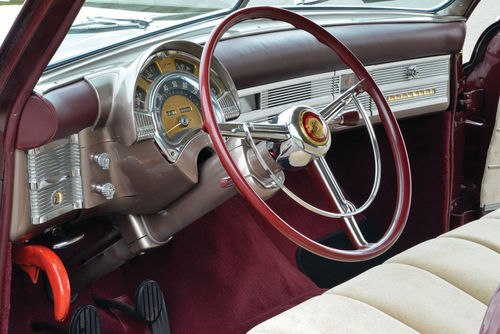
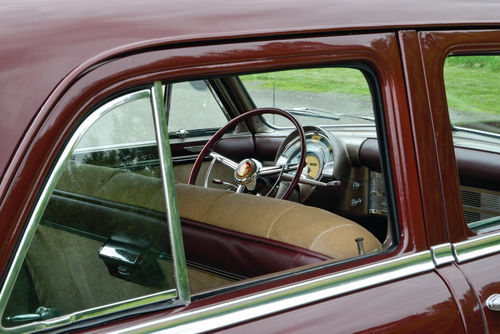
At Chrysler, the 1946 model was “the beautiful Chrysler with hydraulically operated transmission and Gyrol Fluid Drive.” Anyone could see that it was a freshened version of the last prewar Chrysler and that wasn’t a bad thing at all. The 1942 model’s horizontal-bar grille had extended around the fenders to the wheelwells and in the case of the uppermost bar, about to the fender’s edge. The fenders themselves flowed only as far as the A-pillar and strips of brightwork trailed from the rear wheelwells to mimic those at the front. Most of that made reworking for 1946 relatively easy and so the grille was changed to something between an egg crate and a checkerboard with only three larger horizontal bars running to the wheelwells instead of the previous five. Bumpers now wore three guards, the front fenders extended into the doors and each rear fender carried only a single piece of trim above the wheelwell and reaching rearward where new taillights completed the package. As it had in 1942, Chrysler offered two inline flatheads for 1946, a 250.6-cubic-inch six in the Royal, Windsor and Town & Country and a 323.5 eight in the Saratoga and New Yorker.
The cars continued essentially unchanged into the 1949 model year, by which time it was clear that the market was now much closer to normal and competition for sales was again necessary. Chrysler was actually late enough that its new cars became the 1949 second series thanks to their mid-year introduction.
Unlike their predecessors, the 1949 Chryslers carried styling that was a complete break with the past. The grille retained the general theme of the first series cars, but it was simplified and the rounded prewar look was gone as surfaces had become flatter and lines straighter. The three-box silhouette that resulted is sometimes criticized for being too upright or too boxy and while those observations are mostly a question of taste, Chrysler had no problem explaining why the car looked as it did.
You Really Appreciate It From the Interior
Advertising detailed how the new car “was designed from the inside out— with your comfort, convenience and safety always in mind. More room for your legs, more room above your head, more shoulder-room. And wider seats that are scientifically designed for chair-height comfort so that you can ride completely relaxed. There’s better visibility, too, in all directions. You can see more out of the new, larger windshield, the wider rear window and the extra-large side windows. The hood is shorter and the steering wheel is lower, so that you have better ‘seeability’ over the front.”
The six and eight were back and advertising told prospects that “the Chrysler Spitfire Engine with highcompression design is powerful, whisper-soft, responsive, and economical,” but it was the ad’s next point that could have been written to catch Martucci’s attention. It would’ve been incredibly farsighted on the copywriter’s part to expect that 61 years later, Martucci would learn for himself that the “Prestomatic Fluid Drive Transmission gives you fast acceleration with liquid smoothness. And it shifts gears for you quickly and quietly—and you can drive all day without shifting if you care to.”
Overheating On the Way Home
The Windsor wasn’t Martucci’s first antique car—that one was a 1958 Packard—and so he wasn’t tempted to compare the Prestomatic to a modern transmission. Instead, he realized that Fluid Drive really was what he’d wanted, but since there was more to consider than just the transmission, the car his wife had found needed a closer look. It seemed to be in fairly good condition, the deal was made and it was ready to be driven home. A previous owner had installed an auxiliary fan, Martucci recalled, and looking back, that might have been taken as something that was there for a reason. He learned about that when he was within a few miles of his house and the car was running too warm, so he did the smart thing and stopped at a restaurant to allow the Chrysler to cool while he and his wife had dinner.
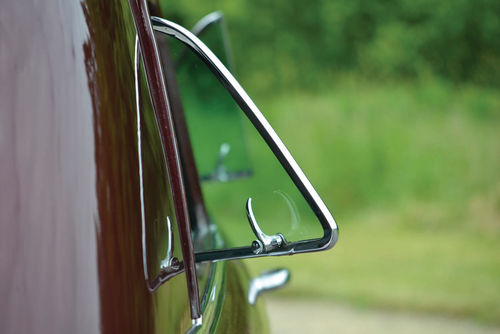

“It cooled down,” he continued, “I got some water from the restaurant, I got it home and I called the guy I’d bought it from. I said ‘what’s the problem? It started overheating and it wouldn’t go.’”
To his credit, the seller soon showed up with an experienced friend and set out to identify the problem and, hopefully, to correct it. Fortunately, what could have turned out to be a nightmare was solved via a solution that was messy rather than difficult as the first hint came when draining the block failed to release as much used coolant as expected.
“He said ‘there’s no water coming out,’” Martucci recalled. “‘There’s nothing there.’ It was blocked. He dug (the blockage) out and I flushed it out, and then I put the antifreeze in.”
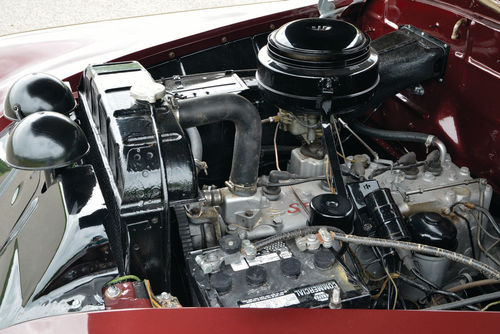
Trouble With the Shifter
The next problem he encountered had less potential to become a nightmare, although someone whose experience was limited to modern cars might easily have been stumped by the semiautomatic transmission’s refusal to shift.
“You’d be in the one gear,” Martucci said, “and it would stick. It wouldn’t shift to second and when you went down to third and fourth, it wouldn’t shift out of third, so here you are, driving down the highway in third gear, thinking you’re OK and you’re not.”
That description requires some explanation for those who’ve never driven a similar Chrysler. The shifter is column-mounted and uses most of the pattern that a three-speed would use, the exception being that the traditional first-gear position is blocked. What would be second is a low-range position where the transmission shifts from first to second automatically and what would be third is high-range with automatic shifting between third and fourth. The clutch is used only to shift between neutral and a driving or reverse position and to move between driving positions, but the automatic feature works smoothly enough that it’s not always obvious. Now…the cause of the problem with the feature car?
“The solenoid was filthy,” Martucci said, “so the mechanic cleaned it off and put it back in and it’s been running perfectly.”
Lucky For Him, It Wouldn’t Start
With less than 60,000 miles on the odometer, the engine needed nothing major and once those few problems that had shown up initially were corrected, he was able to drive the car and enjoy it.
The Chrysler looked good, but after a few years, the time to begin its restoration was nearing and its failure to start at a local car show became a doubly lucky break when a member of the show staff said he’d find some help for him.
“Well, this guy owned a garage a couple of miles away from the show field,” Martucci recalled. “I didn’t know who he was then, but he said ‘I’ll help you out.’ He was all dressed, he got out and he was all covered with grease and mud and everything, so I gave him all the money I had left in my wallet. He wasn’t going to charge me, but I gave him what I had.”
While it was lucky enough that someone was willing to get dirty in helping a stranger, Martucci’s truly good fortune was that his new friend was a restorer who really liked Chryslers. Mark Wegrzynowicz agreed to take on the project, and as in many restorations, there were surprises.
“He did find that a lot of what I thought was solid wasn’t,” Martucci said. “There was a lot of rust on there, but you don’t know that until you strip it down.”
Rust May Be Visible Or Hiding
Chryslers of the era have fairly strong sheet metal, but few cars can survive decades of winters in the Northeast without showing rust. Damage from rust on Chryslers like Martucci’s—and on the similar DeSotos, Dodges and Plymouths—typically shows up in mostly the same areas where it would be found on other cars of the time. Rocker panels, lower front fenders, door bottoms and the lower sections of the pillars are likely problem sites as are the front floor in the passenger compartment and the trunk floor.
Rust in nearly any of those areas should be detectable fairly easily, but a few other points could easily go unnoticed. One of those potential rust areas is inside the upper part of the rear fender where debris accumulates and holds moisture. As the rust grows serious, it becomes visible on the outside and can even show up on the quarter panel above the fender.
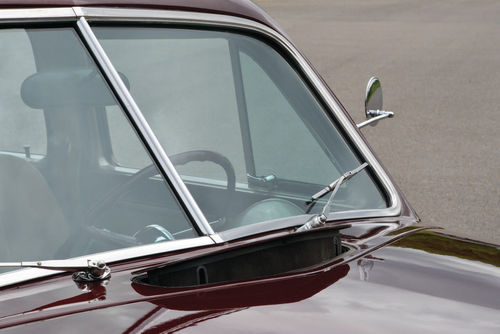
Similarly, any of that brightwork can hide a surprising amount of rust and Martucci knows about that since much of the feature car’s rust was waiting behind the trim. The good news, though, was that most of the trim itself was salvageable and needed only straightening and buffing. Just as important was the fact that while the interior needed to be reupholstered, the somewhat delicate window cranks and interior door handles were fine.
Glad To Have It Back
The feature car was back on the road last year and even if there was a bit of exaggeration in the advertising in 1949, it’s easy to understand why Martucci likes it as much as he does today. It’s equally easy to appreciate many of the ads’ major statements about “The Beautiful Chrysler,” particularly when it comes to claims like “luxurious is the word for it. Tailored to taste with rich fabrics, skillfully fashioned over deep, wide cushions…” All of that appeals to Martucci and since he was without the Chrysler during its restoration, it appeals to him even more now.
“I’d usually drive it about 300 miles a year,” he said of its pre-restoration life. “I’d just go to the car shows and sometimes, I’d ride around the area. I’d say probably close to 600 or 700 now because I missed it for those years. I’ve got to make up for lost time.”
If that figure doesn’t seem to translate to a lot of driving, it has nothing to do with any worries about the Chrysler’s readiness to travel a few hundred miles.
“We can go right now,” Martucci offered, “if you want to go.”
There’s a Generation Gap Here
Tempting as it was to spend all day in the car, a short test drive was more practical. It wasn’t the first time I’d driven a Chrysler with a semiautomatic transmission and so the only learning curve was a brief one while I adjusted to Martucci’s car.
Someone who’d never driven anything like it—but knew how to drive a three-speed with a columnshifter—might’ve cringed at seeing me attempting to start from a dead stop in what seems to be second gear, but that position is just the lower range. He might also be prepared for a somewhat abrupt slowing as he watched me back off the gas, but the quiet clunk that followed as it upshifted would, I hope, have shown that I really do know how to drive it.
Moving the shifter into what would be third gear on a conventional three-speed and lifting again at the right road speed repeats the process between third and fourth, but more surprising would be not bothering to step on the clutch when stopping and then simply stepping on the gas to start up again.
Obviously, General Motors’ HydraMatic or Packard’s Ultramatic would be even easier to drive as either would be about as complicated as a modern automatic, but it’s difficult to fault the Prestomatic. For that matter, there’s really not much to complain about with the feature car. Its seating position is fine for a tall driver, visibility and the brakes are good for a car of its time, the sound level is low and Martucci predicted that a first-time driver would quickly end up wanting one like it.
“Once you’d get used to driving it,” he promised, “give yourself 20 minutes or so, maybe 30 minutes, then I think you’ll have your mind made up by that time.”
If that hypothetical first-time driver did fall for it and decide to buy one, he’d need to accept differing reactions to his car. Martucci explained that it always draws attention when he stops for gas and many of those who see it will say that they like it and then ask about its make. But there’s more…
“When I go to car shows,” Martucci said, “the young people don’t like it. They’d rather go to the muscle cars. Now, the ones who come to the car are the fathers and the grandfathers and maybe the older uncles because either their parents had one or they drove one and they liked it. It brings back a memory to them.”
Interest in the Chrysler and compliments on it are more of a bonus because for Martucci, it really was the right choice.
“The other part of it,” he explained, “is that this type of car really doesn’t have a sexy body design. It’s just a regular body put together for usefulness. It’s not made to look sharp. It does, but what I meant is that (compared to) these other cars, it doesn’t have the design; there’s no flash to it. It’s just a plain car, but I like the car… How could I give it up? It’s such a nice car.”
















